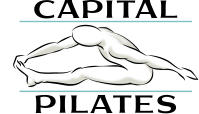


by Angela, Studio Owner
I love Pilates and all the benefits it provides, and watching what it can do for
others. I have also been a student for many years, and enjoy visiting studios and teachers to pick-up new
ideas and techniques. Of course I would like you to try Pilates at Capital Pilates, but you need to find
whatever avenue is productive and enjoyable for you. We all respond differently to each circumstance and
instructor so there is no ideal path.
With that in mind, let me answer a few of the more frequent questions potential students have:
What makes a good Pilates instructor?
Pilates takes many years to master, and a good instructor will use the full repertoire of experience to tailor
routines to even a beginner. A good instructor should “tune-in” to you, and interactively direct you rather
than follow a set script. Over time, they may notice things you didn’t notice about yourself, such as favoring
certain muscles or executing unbalanced motions. It’s important that an instructor not just be able to
perform and direct the exercises, but understand their purpose (for example what muscles they are
targeting and in what way). This allows the instructor to use her knowledge to design routines based on
their particular student’s body. A basic understanding of anatomy is very important in this regard.
Is that much detail really important?
Yes, let me give you an example: Sit on a park bench one day and watch people run. You’ll probably be
amazed that no two people run in the same manner, even though they are “accomplishing” the same result.
But, the more each person deviates from running as “naturally” as the body intended, the more problems
result. The small imbalances and misalignments can lead to knee, back, foot, and hip problems over time,
although people rarely make the connection. Pilates is about using the body correctly. However, people may
be running sub-optimally for good reasons: most bodies have natural problems, some of which are
correctable and some that are not. That’s why a deep understanding of the body and the exercises will help
the instructor tailor the training to what is closest to ideal for that particular person.
What about classes at the gym or community center?
Most classes outside of a studio do not have a full-range Pilates equipment (or even any). There are
exceptions to this, however, so it’s best to ask. Pilates has become popular, so be wary of someone tacking
the word “Pilates” onto a generic exercise class. Proper certification involves hundreds of hours of practical
experience and years to master.
What about doing it at home?
This can be very cost effective and convenient of course. I have produced an Audio CD that some of my
students use at home so I understand the need. Equipment requirements aside, there are two primary
problems with self-teaching. First, Pilates is less about doing particular exercises than it is about how you do
them. Think “lift with your legs not your back.” Having an instructor both cue you and watch you are
essential for achieving results, and also avoiding injury. Secondly, an experienced instructor will watch your
body and make adjustments that best deal with any imbalances or idiosyncrasies you have (everyone does).
This may sound minor, but it can lead to significant improvements in your daily movement from my
experience. Even expert teachers continue to take classes from an instructor.
There are a number of Pilates Studios in the area. How do I choose?
Most of the local Pilates studios are well equipped (I have taken classes at most them) and they have some
very good instructors. So the short answer is you should experiment. Private or small group classes mean
you have a very close-knit relationship with your teacher. In addition to him/her needing to be skilled and
experienced, you of course should feel comfortable with each other. Think of it a little like dating.
What else should I consider?
Don’t forget the small things: convenience, price, and reliability. As with any exercise routine, the fewer
obstacles you face, the more likely you are to stick with it.
What do you recommend to get started?
I recommend signing-up for a few private classes so your instructor can spend time “getting to know your
body.” Then you can both jointly evaluate what will best suit your time, needs, and budget.
If you have more questions, please visit our Client Comments page, or contact me.
We hope you’ll give Pilates a try.

